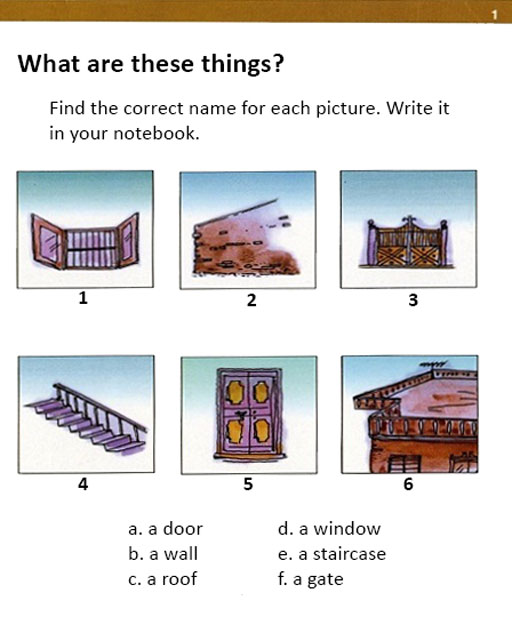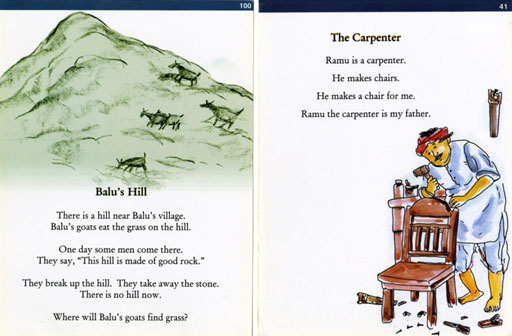3 Resources for reading silently
Students should be given opportunities to read silently in class. This is most likely to be the kind of reading they will do in real life. To prepare your students to read on their own, you can use ‘reading cards’: small booklets or cards with short texts or stories that are graded according to difficulty. You can prepare your own grade cards by copying out simple texts or stories from English textbooks of different types. You can either write out some of the questions given as part of the exercise in the textbook, or make your own questions.
Activity 3: Exploring reading cards for silent reading
Figure 1 shows an example of a word reading card for the beginner. Each card has pictures for a group of words that have related meanings, and the same instructions. To begin with, you can explain the instructions to your students in their language.
Figure 1 An example of a reading card.
Figure 2 shows two more reading cards, this time with short stories.
On the back of each card are some questions, listed below. Do you think they are easy or difficult? Which class should a student be in to be able to read these cards and answer the questions by themselves?
‘Balu’s Hill’
Choose the right words:
- Balu’s village is near a ______ (hill, river).
- Balu has some ______ (dogs, goats).
- The goats eat ______ (stone, grass).
- The hill is made of ______ (rock, grass).
- The men take away the ______ (grass, stone).
‘The Carpenter’
Choose the right words:
- Ramu is a ______ (farmer, carpenter).
- Ramu makes ______ (cars, chairs).
- Ramu makes a ______ (chair, table) for me.
- Ramu is my ______ (mother, father).
Do you have experience of using reading cards? If so, what do you think are the benefits and problems of students using them?
Do you have reading cards available to you, but have not ever used them in the classroom? What has prevented you from using them?
Do you think you could make your own reading cards, perhaps based on a textbook lesson? How would you design these for students who need remedial work?
Reading cards allow students to monitor or evaluate their own comprehension as they proceed from less difficult to more difficult cards. Students can choose their own ‘level’ of card to read: if a card is too simple, they can jump forward; if a card is too difficult, they can go back to a simpler card.
Activity 4: Making reading cards
Make a very simple set of reading cards. You can choose English vocabulary, a very short poem or story, or a set of facts for a subject (for example, names of animals or parts of the body).
- Get scissors, stiff card and paste.
- Cut out six cards – large enough for a student to hold and read easily.
- Select vocabulary or a very short text.
- Write the text on one side of the card.
- Draw or paste pictures, if appropriate.
- Write simple questions about the text on the other side of the card.
Plan a 30-minute session where you give the cards to a small group of students (no more than six). Have them read the cards and answer the questions in their notebooks.
You could organise this group at the same time and in the same way as your small reading aloud group (Activity 2). The rest of the class must be given quiet work to do on their own. Tell the class that everyone will have a chance to work in a group with the reading cards. Explain that the texts are short and the questions are simple, so students should be able to answer them on their own. It is a chance for students to develop the skill of independent working.
You can monitor and evaluate your students’ silent reading by seeing how many cards they read in the time given, at what level, and whether or not they get the answers right. You can also ask your own questions to assess students’ understanding.
In the next section, the focus is on guided reading in ability groups. As you read, think about how reading cards could be used for guided reading.
2 Getting your students to read aloud


